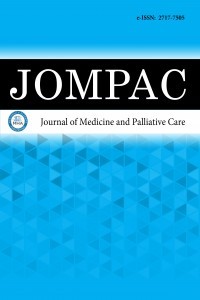Böbrek nakli ve hemodiyaliz hastalarında yaşam kalitesini etkileyen faktörler farklılık göstermektedir
Böbrek nakli, hemodiyaliz, yaşam kalitesi
The effects and differences of kidney transplantation and hemodialysis treatments on quality of life
Hemodialysis, quality of life, renal transplantation,
___
- Süleymanlar G, Utaş C, Arinsoy T, et al. A population-based survey of Chronic REnal Disease In Turkey--the CREDIT study. Nephrol Dial Transplant 2011; 26: 1862-71.
- Wyld M, Morton RL, Hayen A, Howard K, Webster AC. A systematic review and meta-analysis of utility-based quality of life in chronic kidney disease treatments. PLoS Med 2012; 9: e1001307.
- Demiral Y, Ergor G, Unal B, et al. Normative data and discriminative properties of short form 36 (SF-36) in Turkish urban population. BMC Public Health 2006; 6: 1-8.
- Kücükdeveci AA, McKenna SP, Kutlay S, Gürsel Y, Whalley D, Arasil T. The development and psychometric assessment of the Turkish version of the Nottingham Health Profile. Int J Rehabil Res 2000; 23: 31-8.
- Atas DB, Arikan H, Ecder SA, Ciftci H. Comparison of Anxiety, Depression and the Quality of Life Between Hemodialysis and Renal Transplantation Patients. Turkish J Nephrol 2017; 26: 171-6.
- Sanchez S, Teelucksingh S, Ali R, Bailey H, Legall G. Quality of life and health status among patients receiving renal replacement therapy in Trinidad and Tobago, West Indies. Int J Nephrol Renovasc Dis 2021; 14: 173-92.
- Johnson CD, Wicks MN, Milstead J, Hartwig M, Hathaway DK. Racial and gender differences in quality of life following kidney transplantation. Image J Nurs Sch 1998; 30: 125-30.
- Liu H, Feurer ID, Dwyer K, Speroff T, Shaffer D, Wright Pinson C. The effects of gender and age on health-related quality of life following kidney transplantation. J Clin Nurs 2008; 17: 82-9.
- Mujais SK, Story K, Brouillette J, et al. Health-related quality of life in CKD Patients: correlates and evolution over time. Clin J Am Soc Nephrol 2009; 4: 1293-301.
- Chisholm-Burns MA, Erickson SR, Spivey CA, Kaplan B. Health-related quality of life and employment among renal transplant recipients. Clin Transplant 2012; 26: 411-7.
- Bohlke M, Marini SS, Gomes RH, et al. Predictors of employment after successful kidney transplantation - a population-based study. Clin Transplant 2008; 22: 405-10.
- Han KT, Park EC, Kim JH, Kim SJ, Park S. Is marital status associated with quality of life? Health Qual Life Outcomes 2014; 12: 109.
- Luttik ML, Jaarsma T, Veeger N, van Veldhuisen DJ. Marital status, quality of life, and clinical outcome in patients with heart failure. Heart Lung 2006; 35: 3-8.
- Jatoi A, Novotny P, Cassivi S, et al. Does marital status impact survival and quality of life in patients with non-small cell lung cancer? Observations from the mayo clinic lung cancer cohort. Oncologist 2007;12: 1456-63.
- Buffart LM, Kalter J, Sweegers MG, et al. Effects and moderators of exercise on quality of life and physical function in patients with cancer: An individual patient data meta-analysis of 34 RCTs. Cancer Treat Rev 2017; 52: 91-104.
- Yardımcıoğlu F. Eğitim ve sağlık ilişkisi: Panel eşbütünleşme ve panel nedensellik analizi. Int J Econ Soc Res 2013; 9: 49-74.
- Kefale B, Alebachew M, Tadesse Y, Engidawork E. Quality of life and its predictors among patients with chronic kidney disease: A hospital-based cross sectional study. PLoS One 2019; 14: e0212184.
- de Groot IB, Veen JI, van der Boog PJ, van Dijk S, Stiggelbout AM, Marang-van de Mheen PJ; PARTNER-study group. Difference in quality of life, fatigue and societal participation between living and deceased donor kidney transplant recipients. Clin Transplant 2013; 27: 415-23.
- Griva K, Ziegelmann JP, Thompson D, et al. Quality of life and emotional responses in cadaver and living related renal transplant recipients. Nephrol Dial Transplant 2002; 17: 2204-11.
- Rubin RR, Peyrot M. Quality of life and diabetes. Diabetes Metab Res Rev 1999; 15: 205-18.
- Jacobson AM. Quality of life in patients with diabetes mellitus. Semin Clin Neuropsychiatry 1997; 2: 82-93.
- Apostolou T, Hutchison AJ, Boulton AJ, et al. Quality of life in CAPD, transplant, and chronic renal failure patients with diabetes. Ren Fail 2007; 29: 189-97.
- Wändell PE, Brorsson B, Åberg H. Quality of life in diabetic patients registered with primary health care services in Sweden. Scand J Prim Health Care 1997; 15: 97-102.
- Cepeda-Valery B, Cheong AP, Lee A, Yan BP. Measuring health related quality of life in coronary heart disease: The importance of feeling well. Int J Cardiol 2011; 149: 4-9.
- De Smedt D, Clays E, Annemans L, et al. Health related quality of life in coronary patients and its association with their cardiovascular risk profile: results from the EUROASPIRE III survey. Int J Cardiol 2013; 168: 898-903.
- Brown N, Melville M, Gray D, et al. Quality of life four years after acute myocardial infarction: short form 36 scores compared with a normal population. Heart 1999; 81: 352-8.
- De Visser C, Bilo H, Groenier K, De Visser W, Meyboom-de Jong B. The influence of cardiovascular disease on quality of life in type 2 diabetics. Qual Life Res 2002; 11: 249-61.
- Chambers BA, Guo SS, Siervogel R, Hall G, Chumlea WC. Cumulative effects of cardiovascular disease risk factors on quality of life. J Nutr Health Aging 2002; 6: 179-84.
- Başlangıç: 2020
- Yayıncı: MediHealth Academy Yayıncılık
Asena AYAR MADENLİ, İnci ÖZ, Tuğba GÜRBÜZ
Hale ATEŞ, Kurtuluş AKSU, İlkay KOCA KALKAN, Musa TOPEL, Senay DEMİR, Selma YESİLKAYA, Sakine NAZİK BAHCECİOGLU
Davut SAKIZ, Murat ÇALAPKULU, Muhammed Erkam SENCAR, Bekir UCAN, İlknur ÖZTÜRK ÜNSAL, Mustafa ÖZBEK, Erman ÇAKAL
Hashimoto tiroiditinde IL-35 düzeyleri ve tiroid fonksiyon testleri ile ilişkisi
Osman İNAN, Feridun KARAKURT, Ali KOŞAR
Ezgi EREM, Fatih Mehmet KIŞLAL
COVID-19 hastalarında uzamış D-dimer yüksekliği ve herediter trombofili arasındaki ilişki
Kadir Serkan YALÇIN, Hümeyra YÜCETÜRK, Benan KASAPOĞLU, Murat KEKİLLİ
Arif Cengiz GÜLTEKİN, Ercan TÜRKMEN, Ferah TARAN, Melda DİLEK, Hayriye SAYARLİOGLU, Nurol ARIK
Melih HANGÜL, Mehmet KÖSE, Hüseyin PÜR, Murat DOĞAN, Emrah TÜRK, Ali ERSOY, Mehmet Adnan ÖZTÜRK
